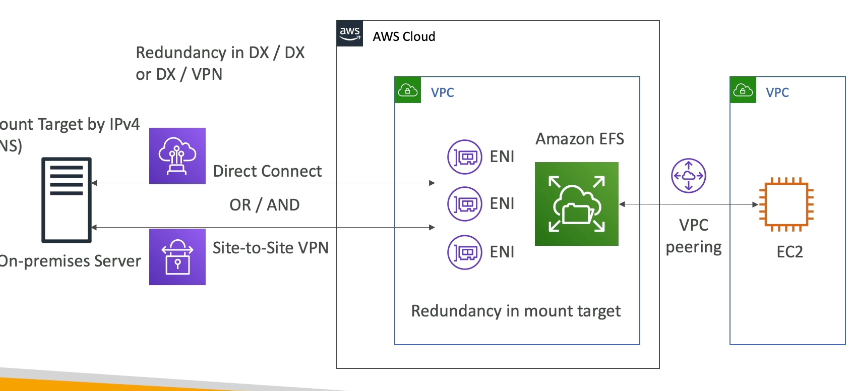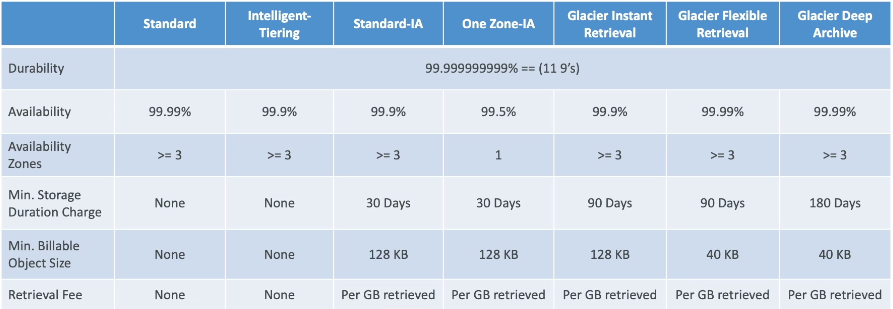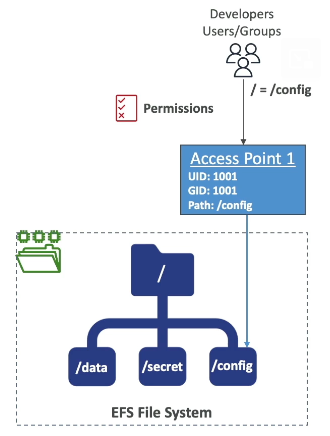Storage
EBS Volumes
- EBS Volumes are network drives
- They are not physically coupled to instances
- Attach to one instance at a time
- Can have multiple EBS Volumes attached to 1 EC2 instance
- Linked to a specific AZ
- To transfer you snapshot and transfer
- Transfer across AZ, region, etc
- Incremental
- Only backup changed blocks behind the scnees
- EBS backups use IO so you shoudln't run them while application is handling a lot of traffic
- Snapshots stored in S3
- Not necessary to detach to do snapshot, but recommended
- Can make AMI from Snapshot
- Fast Snapshot Restore is a feature that pre-warms your EBS volumes for you so that once the instance is up and EBS volume attached all of the blocks are ready to go and no cold start problem
- To transfer you snapshot and transfer
- Can only scale them up
- Volume Types
g: General Purpose SSD for wide variety of workloadsiHighest Performance SSD for mission-critical low latency or high-throughput workloadsst 1Low cost HDD for frequent access and high throughputsc 1Lowest cost HDD for less frequently accessed workloads- Types characterized by Size, Throughput, and IOPS
- Encryption
- EBS volumes aren't encrypted by default
- Acct level setting to encrypt automatically new EBS volumes and snapshots
- EBS Multi-Attach
- This allows us to attach same EBS volume to multiple EC2 isntances in the same AZ
- We mentioned above this wasn't possible, so this service is only for very specific use cases
- Achieve higher app availability in clustered linux application
- Apps that manage concurrent write ops
- Must use FS that's cluster-aware
- Each instance has full read and write permissions to the volume
Amazon Data Lifecycle Manager
-
Automate creation, retention, and deletion of EBS snapshot and EBS backed AMI's
-
Schedules backups, copies, snapshots, and deletions
-
Use resource tags to identify resources
-
Can't manage snapshot / AMI outside of DLM
-
AWS DLM vs AWS Backup
- DLM for creation, retention, and deletion of EBS snapshots
- AWS Backup for management and monitoring of backups across AWS services from a single place
- Includes EBS volumes
Local EC2 Instance Store
-
EC2 instance store is the physical disk attached to physical server where EC2 is
-
Very high IOPS
-
Disk up to 7.5TB, if you strip or parallelize many you can get up to 60 TB
-
Block storage like EBS
-
Data is lost if hardware fails
-
Instance Store vs EBS
- IS physically attached to machine
- Data doesn't survive reboot
- EBS is network drive
- Data survives reboot
- IS physically attached to machine
EFS
- Elastic File System
- Managed Network File System (NFS) that can be mounted on many EC2
- Multiple EC2, multi AZ, and can be across on prem and on cloud
- Highly available, scalable, and expensive file system - you pay per GB used
- Use cases:
- Web serving, content management, data sharing, WordPress
- Need linux based AMI that's POSIX compliant
- NFS v4.1 protocol
- Encryption at rest via KLMS
- Can only attach to one VPC and one ENI (mount target) per AZ
- Scales automaticall
- Performance and Storage Classes
- EFS Scale
- 1k's of concurrent NFS clients
- 10 GB/s throughput
- Grow to petabyte scale NFS automatically
- Performance Mode
- General: latency sensitive
- Max I/O: higher latency, throughput, and highly parallel
- Throughput Mode
- Bursting: 1TB = 50 MB/s + bursts up to 100MB/s
- Provisioned: Set throughput regardless of storage size
- Elastic: Auto scales throughput up or down based on workloads
- Good for unpredictable workloads
- EFS Scale
- Storage Classes
- Standard: Frequently accessed files
- Multi AZ, good for prod
- Can use one single AZ for dev purposes
- Infrequent: Cost to retrieve files, but much lower to store
- One Zone IA is best to use
- Archive: Rarely accessed data, and 50% cheaper
- Implement lifecycle policies to move files between storage tiers
- Standard: Frequently accessed files
On Prem and VPC
-
Can use VPC peering for VPC-2-VPC connection between EC2 and EFS
- EC2 instance can use DNS or IP of EFS
-
Can use Direct Connect and/or Site-To-Site VPN for On-Prem server to connect to EFS
- Need to attach EFS to one or many ENI, and then On-Prem needs to connect to IPv4 address of ENI, they cannot use DNS address

- Need to attach EFS to one or many ENI, and then On-Prem needs to connect to IPv4 address of ENI, they cannot use DNS address
-
Security:
- Can use IAM + POSIX user and groups to control access to directories on file system
- File System Properties:
- Resource-based policy to control access to EFS file systems
- Same thing as S3, but can control read/write
- By default it grants full access to all clients
- Resource-based policy to control access to EFS file systems
- Can use IAM + POSIX user and groups to control access to directories on file system
-
Replication
- Cross region replication
- New and/or existing EFS file systems
- SAme exact FS in another region
- Doesn't affect throughput as this is done in backend away from EFS
- Use case:
- Meet compliance needs of DR / business continuity
S3
- Object storage, serverless, unlimited storage
- Good for static content like image and video
- Access object by key
- NOT A FILESYSTEM
- Anti Patterns:
- Lots of small files
- POSIX file system (use EFS instead since it has file locks)
- Search features, queries, and rapidly changing data
- Websites with dynamic content

- Can use S3 lifecycle policies to move between these storage classes
- Replication
- Cross Region Replication (CRR)
- Same Region Replication (SRR)
- Can combine both of these with other lifecycle rules
- Helps to reduce latency and disaster recovery
- S3 Replication Time Control (S3 RTC)
- Replicates most objects that you upload to S3 in seconds with 99.99% of objects with SLA < 15 minutes
- Helps for ensuring SLA on compliance
- Event Notifications
- S3 can send event notifications to multiple targets
- Event types
- Object Created, Removed, Restored, Replicated, etc...
- Targets
- SQS, SNS, Lambda, or EventBridge
- With EventBridge a common architecture is to send every single S3 event there, and then EventBridge is able ot interact with 18 other AWS services that can all "do things"
- EventBridge can do advanced filtering with JSON rules
- Multiple destinations for one rule
- Proper PubSub of messages based on Events in S3
- Use cases:
- Thumbnail uploads onto S3 we want to return
- Baseline performance
- Automatically scales to high requests, with latency between
100ms - 200ms - Can achieve these metrics per second per prefix
3,500 PUT/COPY/POST/DELETE5,500 GET/HEAD- Prefix = everything after bucket name:
<bucket_name>/prefix.../../../ - Spreading reads across prefixes can get you to
22,000 rps
- Automatically scales to high requests, with latency between
- Higher performance
- Multi part upload
- Recommended for files > 100MB
- Can help parallelize uploads
- Chunk out file, upload all, then reconstruct back together on S3
- S3 lifecycle policy to abort multi-part upload of it doesn't complete
- S3 Transfer Acceleration
- Transfer file to AWS edge location which then forwards to S3 bucket in target region
- Compatible with multi-part upload
- Public location from client to edge location, then AWS backbone from edge to S3
- S3 byte range fetches (Downloads)
- Separate file into chunks of bytes
- Parallelize GET requests by requesting specific byte range
- If one part fails we just re-request that one part
- Also useful for only requesting headers of files, instead of GET whole file
- Multi part upload
S3 Storage Class Analytics
- AKA Storage Class Analysis
- Helps decide when to transition objects to the right storage class
- Recommendations for Standard and Standard IA
- Doesn't work for One-Zone IA or Glacier
- Report updated daily
- Visualize in AWS Quicksight
S3 Storage Lens
- Understand, Analyze, and Optimize storage across entire AWS org
- Find anomalies, cost efficiencies, and data protection best practices
- Aggregate data for Org, accounts, regions, buckets, or prefixes
- Summary Metrics:
- General insights about S3 storage
- StorageBytes, ObjectCount, etc.
- Use cases: Identify the fast growing, unused, and "normal" buckets and prefixes
- Cost Optimization Metrics:
- Provide insights to manage and optimize storage costs
- NonCurrentVersionStoragebytes, IncompleteMultipartUploadStorageBytes
- etc...
- Data Protection
- VersioningEnabledBucketCOunt
- etc - lots of metrics around if we are protecting data
- Access Management Metrics
- Event Metrics
- Performance Metrics
- Activity Metrics
- Detailed Status Code Metrics
- 20OKStatusCount
- Free vs Paid
- Free
- Automatically available for all cusomters
- 28 usage metrics
- Data available for 14 days
- Paid
- Additional + Advanced metrics
- CloudWatch Publishing
- Prefix Aggregation
- Data available for 15 months
- Free
S3 Solution Architecture For Exposing Static Objects
- Stand up EC2 with static content
- Use CloudFront in front of EC2 with EBS on it
- Caches static content globally
- CloudFront in front of ALB
- ALB in front of ASG of EC2 which are all connected to EFS
- EFS is on network, so it scales
- CloudFront in front of S3
- Works great for static objects that aren't updated often
Indexing Objects
- We can't natively index objects in S3, to do search we'd need to check all files / prefixes
- On new writes to S3 we can use an Event Notification to trigger a lambda function
- Lambda would write object metadata and update indexes on DynamoDB
- Search by date, total storage used by customers, find all objects w/ certain attribute, etc...
Dynamic vs Static
- To serve both dynamic and static content
- DNS query on Route53
- Dynamic content sent to API GW + dynamic backend
- Very little cyachying here
- Static content goes through CDN CloudFront layer
- Pulls from S3
- Lots of cyachying here
- Dynamic layer could upload data to S3 backing static layer
- Can use Event Notifications and Lambdas to talk between the 2 layers as required
- Dynamic content sent to API GW + dynamic backend
FSx
- Launch 3rd party file systems on AWS
- Fully managed systems
- Similar to RDS hosting database, but we host File Systems
- Types:
- Lustre
- Large scale distributed file system
- LinuxCluster = Lustre
- ML and HPC
- Video processing, financial modeling, etc
- SSD for low latency IOPS intensive lots of small file workloads
- HDD for throughput intensive large sequential file operations
- Integrates with S3, can use S3 as a FS into FSx
- Can write output back to S3
- Accessible from on-prem infra with VPN or DirectConnect
- 2 types:
- Scratch
- Temp storage, data not replicated, etc...
- Much higher burst and IOPS
- Short term processing of data and cost optimization
- Multiple compute across AZ's connect to ENI that sits on FSx
- Can replicate to S3 if needed
- Persistent
- Long term storage
- Data replicated within same AZ
- Replace failed files within minutes
- Use for long term processing and sensitive data
- Same architecture as above, but there are multiple disks backing up the FSx resource
- Scratch
- NetApp ONTAP
- Compatible with NFS, SMB, iSCSI protocol
- Move workloads running ONTAP or NAS to AWS
- Works with many Linux and Windows instances
- Scales storage automatically
- Replication, snapshots, compression, de-duplication, etc
- Point In Time instantaneous cloning
- Windows File Server
- Fully managed Windows shared drive
- SMB protocol and Windows NTFS
- Microsoft AD integration with ACL, user, and quotas
- Can be mounted on Linux EC2 instances? Lol
- Supports Microsoft Distributed File System Namespace to group files across multiple file systems
- on-prem and cloud, or just across multiple cloud file systems
- SSD or HDD based
- Data backed up daily
- Can be configured to Multi-AZ HA
- Accessible from on-prem infra with VPN or DirectConnect
- OpenZFS
- Only compatible with NFS protocol
- Move internal workloads running on ZFS to AWS
- Works with many Linux and Windows instances
- Snapshots, compression, etc
- Point In Time instantaneous cloning
- Up to 1M IOPS with < 0.5ms latency
- Lustre
FSx Soln Arch
- Single AZ to Multi AZ
- Use DataSync to replicate from FSx Single AZ to FSx Multi AZ
- Shut down Single AZ, manual backup to Multi, restore Multi AZ
- Decrease FSx volume size
- Can only increase
- If you take a backup, you can only restore to same size
- Therefore, we must use DataSync
- Standup smaller FSx
- Use DataSync for some portion of first FSx to smaller second FSx
- Some stupid lazy loading thing for FSx that shouldn't be on the test
- Any data processing job on Lustre with S3 as input can be started without Lustre doing a full download of dataset
- Data is lazy loaded, only the data that's actually processed is loaded
- This means you can decrease cost and latency!
- Just dive in to this super abstract and unnecessary feature, and ensure you are getting the most out of your AWS Service!
DataSync
- Synchronize data!
- Move large amounts of data to and from places
- On-Prem, other clouds, etc...
- Needs an agent on-prem or on the other cloud to do this
- One agent can use 10 GB/s, but we can setup a bandwidth limit too
- AWS Service to Service
- No agent needed
- Can sync to:
- S3
- EFS
- FSx
- Replication task can be scheduled hourly, daily, weekly
- File permissions and metadata are preserved
- Compliant with NFS POSIX
- This is the only service that can keep metadata during replication
- Multiple on-prem or other cloud servers can sync to one DataSync service
- We can also go the other way and sync services back to on-prem or other cloud
- Need DataSync agent in each network that needs to get synced
- AWS SnowCone
- This happens when we don't have network capacity for DataSync
- SnowCone device comes with agent pre-installed
- SnowCone pulls data locally, shuts down, and gets shipped to AWS to be uploaded onto cloud
- AWS Service to Service
- S3
- FSx
- EFS
- Can just sync to and from each
- Metadata is kept
- Metadata is kept
- Metadata is kept
- Not continuous, it is a scheduled job
- How can we do AWS DataSync through private channels and not public?
- Need DirectConnect, PrivateLink, and Interface VPC Endpoint

Data Exchange
- Find, subscribe to, and use third-party data in cloud
- Once subscriped to you can use Data Exchange API to load directly into S3 or RedShift
- We can also license our own data through RedShift onto Exchange
Transfer Family
- Send data in and out of S3 or EFS via only the FTP protocol
- Protocols
- File Transfer Protocol (FTP)
- File Transfer Protocol over SSL (FTPS)
- Secure File Transfer Protocol (SFTP)
- Pay per provisioned endpoint
- Managed infra
- Integrate with existing auth system
- Used for sharing files and public dataset
